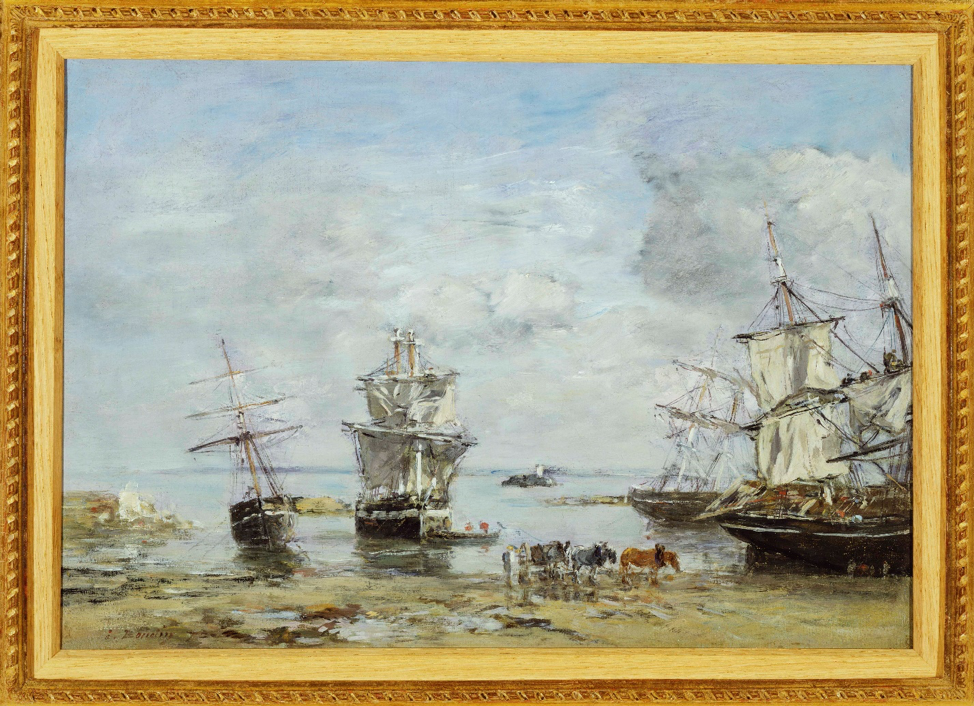As a private dealer, I sell works of art for clients, but if a client has a painting that isn’t a 19th or 20th century American work, my list of prospective collectors for the painting will be limited, and in such cases I often recommend that the client send the work to auction. I then become the client’s representative with the auction houses, getting estimates to compare, providing independent advice on which auction house to choose, and then helping with shipping and other administrative matters in the months before the sale.
I recently helped place this painting in next month’s Impressionist and Modern Sale at Sotheby’s. It’s by Eugene Boudin (1824-1898). Boudin was the son of a harbor pilot in Normandy and spent a lot of time on ships as a boy. When his father left the sea in 1835 to open a shop selling stationery and picture frames in Le Havre, Boudin worked in the shop, meeting many artists who encouraged him. At the age of 22, he began to paint full time, specializing in scenes of the harbors he knew so well. This painting, Low Tide, Portrieux, was painted in 1875 at Portrieux, a harbor on the northern coast of Brittany. Paintings such as this one made Boudin one of the most celebrated marine artists in France. He exhibited at the Salon and was eventually made a Knight of the Legion of Honor.

And here is where desire, the subject indicated by my title, comes into play. When a painting is offered at auction, an estimate must be set, and estimating what a work might bring is an art, not a science. In the case of a prolific artist such as Boudin, you have many sales results with which to compare, but setting the estimate is still a gut-check experiment. You want the estimate to be just low enough to entice every would-be buyer to pursue it. Too high, and some buyers may decide the painting is too expensive for them and will not even bother to bid on it. Too low, and the collectors who are bidding may lose heart when the bid goes above the estimate, thinking “Am I crazy to keep bidding?” You want prospective buyers to think they have a chance to own the painting, and then you want them to keep bidding, even if the price goes above what they intended to pay.
There are two other harbor scenes by Boudin in Sotheby’s sale next month, each of them within an inch of the same size as my client’s painting. One of them has been estimated at $80,000-120,000. The other one has been estimated at $50,000-70,000. After talks with Sotheby’s and discussions between my client and me, we agreed to set the estimate for his painting at $70,000-90,000. All three Boudins come up at the end of the morning session, one right after the other, and my client’s painting is the last of them.
Enormous amounts of ink have been spilled in the discussion of placement of lots in auctions. Generally speaking, no consignor wants his painting to be the first lot in the sale, as some potential bidders invariably arrive late. Generally, no one wants his lot to be the last lot in the sale, either, as people begin to trickle out late in the session, heading for lunch or dinner. Even if the departing persons weren’t intending to bid on the late lots, an emptying room lacks the atmosphere of eager expectation that can make bidders get excited and blow past the ceilings they had set for themselves.
If you’re consigning, say, a large 1950 drip painting by Jackson Pollock, you have a lot of power, since any auction house would kill to be able to offer the painting. I suspect that the house would agree to put the piece wherever you wanted in the order of sale. With a painter as prolific as Boudin, however, the houses want a good painting, but there will always be another by the artist, so the houses don’t feel the need to cede a lot of power to consignors. I would have preferred an earlier placement, but this is the one we have,
Then there’s the matter of the order of the paintings. The first one, as I have said, is estimated at $80,000-120,000. Will bidders see it as the best Boudin, since the estimate is higher? Will they think that it’s overpriced, compared with the following two paintings, and save their bids for one of those, feeling that they’re better bargains? Will the unsuccessful bidders for the first two Boudins bid higher than they planned to for my client’s piece, knowing that it’s their last chance to get a fine piece in this sale?
As you can guess, it’s easy to tie yourself up in knots trying to predict auction results. In the end, nobody really knows. There have been first-lot paintings that have brought record prices for the artist, and there have been very successful last-lot paintings as well. An 1875 Boudin about half the size of this one brought $94,300 at a Paris auction last month. An 1894 oil, larger than this one failed to sell at an estimate of about $50,000-70,000 (Euro price approximation in dollars).
Selling at auction can be a heady experience when the consigned painting exceeds the estimate. Offering a work at auction can also be quite risky, with real downsides if the consigned painting fails to sell. I can help you set realistic, conservative estimates and negotiate the auction process. Let’s talk.

